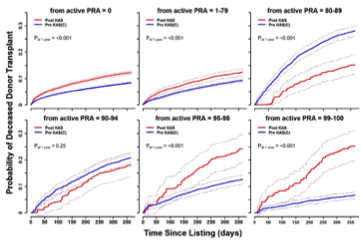A Multistate Modeling Analysis of Time-Varying CPRA States and Its Impact on Kidney Transplant: A Focus on KAS Implementation.
1Surgery &
Medicine, Yale School of Medicine, New Haven, CT
2Medicine, Utah School of Medicine, Salt Lake City, UT
3United Network of Organ Sharing, Richmond, VA
4Center for Analytical Sciences, Yale School of Public Health, New Haven, CT
Meeting: 2017 American Transplant Congress
Abstract number: A95
Keywords: Allocation, Kidney transplantation, Sensitization, Waiting lists
Session Information
Session Name: Poster Session A: Deceased Donor Issues I: Allocation, KDPI and Recipient Selection
Session Type: Poster Session
Date: Saturday, April 29, 2017
Session Time: 5:30pm-7:30pm
 Presentation Time: 5:30pm-7:30pm
Presentation Time: 5:30pm-7:30pm
Location: Hall D1
Background: Highly sensitized kidney transplant candidates are at higher risk of death on the waiting list(WL). OPTN policy change 8(Kidney Allocation System(KAS)) aimed to improve transplant rates for these patients. As time-varying covariates, the level of sensitization(CPRA state) and waitlist status(active, inactive) can be used to predict the probability of WL outcomes and to evaluate the impact of KAS using a multistate modeling framework. Methods: Retrospective cohorts of adult kidney transplant candidates were created from the OPTN database–candidates registered before KAS(10/01/2009-12/04/2013) and after its implementation(12/04/2013-06/17/2015). The combination of 6 CPRA categories and 2 WL statuses led to 12 intermediate states. Using a multistate framework, we estimated transition probabilities between intermediate states and the following terminal states(competing risks): transplant(living), transplant(deceased), death, or other WL removal. We evaluated the impact of KAS on new listings by comparing these cohorts. Then we relaxed event censoring at KAS implementation to analyze the impact of KAS on the pre-KAS cohort. Results: Patients listed post-KAS with CPRA 80-89% had lower probability of deceased-donor transplant compared to those listed pre-KAS(p<0.001). Patients listed post-KAS with CPRA of 0%, 1-79%, or 95-100% had higher transplant probability compared to those listed pre-KAS(p<0.001). Relaxing right censoring at KAS implementation in the pre-KAS cohort confirmed the observed effect of the KAS policy change. Conclusion: Multistate modeling shows how time-varying CPRA states and WL status impact patient outcomes. After KAS implementation, the likelihood of deceased donor kidney transplant either increased or did not change significantly for all actively listed candidates except for those with CPRA of 80-89%, who experienced a decline.
CITATION INFORMATION: Kulkarni S, Hall I, Formica R, Stewart D, Greene E, Deng Y. A Multistate Modeling Analysis of Time-Varying CPRA States and Its Impact on Kidney Transplant: A Focus on KAS Implementation. Am J Transplant. 2017;17 (suppl 3).
To cite this abstract in AMA style:
Kulkarni S, Hall I, Formica R, Stewart D, Greene E, Deng Y. A Multistate Modeling Analysis of Time-Varying CPRA States and Its Impact on Kidney Transplant: A Focus on KAS Implementation. [abstract]. Am J Transplant. 2017; 17 (suppl 3). https://atcmeetingabstracts.com/abstract/a-multistate-modeling-analysis-of-time-varying-cpra-states-and-its-impact-on-kidney-transplant-a-focus-on-kas-implementation/. Accessed December 18, 2025.« Back to 2017 American Transplant Congress
